Graphon
– the intentional violation of the
graphical shape of a word (or word combination) used to reflect its
authentic pronunciation.
Functions of Graphon:
-
serves
as a means of speech characterization supplying information about
the speakers origin, social and educational background, physical or
emotional conditions etc.; -
often
creates a humorous effect; -
it
helps to convey the atmosphere of authentic life communication some
amalgamated forms that are result of assimilation. (gonna, lemme) -
used
in advertisement to attract the audience with an unusual form
(sooper).
Other graphical means used in
stylistics to emphasize the unheard phonetic characteristics – the
pitch of the voice, the stress and other melodic features:
-
punctuation
marks – a series of dots,
dashes, exclamation and question marks; -
spacing
of the graphemes (multiplication
– laaarge; high phonation
– a-l-o-n-e; capitalization –
HELP) -
different
types of print: bold type,
italics; -
a
specific arrangement of printed materials.
20. Morphological means and devices of stylistics: sd based on the use of nouns; sd based on the use of articles.
The
main unit of the morphological level is a morpheme
—
the
smallest meaningful unit
which can be singled out in a word There are two types of morphemes:
root morphemes and affix ones. Morphology chiefly deals with forms,
functions and meanings of
affix morphemes.
Affix
morphemes in English are subdivided into word-building and
form-building morphemes.
In the latter case affixation may be: 1)
synthetical
(boys,
lived, comes,
going)
2)
analytical
(has
invited, is invited, does not invite); 3)
based
on the alteration of the root vowel
(write
—
wrote)’,
4)
suppletive
(go
—
went).
There
are few language (or paradigmatic) synonyms among English morphemes
and
only some of them form stylistic oppositions, e.g. he
lives- he does live. Come! —Do
come! Don’t forget- Don’t you forget This
scarcity of morphological EM which is predetermined
by the analytical character of the English language is compensated by
a great
variety of SD.
Morphological
SD as a deliberate shift in the fixed distribution of morphemes can
be
created by means of: a) the violation of the usual combinability of
morphemes within a word, e.g. the plural of uncountable nouns (sands,
waters, times), or
the Continuous
forms of the verbs of sense perception (to
be seeing, to be knowing, to be feeling):
b)
the violation of the contextual distribution of morphemes, which is
called form transposition.
SD
BASED ON THE USE OF NOUNS
The
invariant grammatical meaning of the noun, that of substance, is
realised through grammatical
categories of number, case, definiteness / indefiniteness which can
be used for
stylistic purposes.
Such
SD may be based on a) repeating the same words in a
syntactical
construction,
e.g. women
are women, or
b) using metaphorically nouns which belong to different
lexico-grammatical
classes, e.g. He
is a devil with the women (S.Barstow).
In
the opposition of singular::
plural the
latter
is a marked member, and, accordingly, the
possibilities of its stylistic use are greater. Nevertheless,
singular forms can also acquire
stylistic meaning ,
e.g.
to
shoot dark, to hunt pig. The
formant ‘s’ as the marker of
the category of possessiveness constantly widens the sphere of its
usage and its combinability.
It frequently combines with inanimate and abstract nouns, e.g.
kitchen’s
work,
the plan’s failure. Sometimes
it refers to a word group or a sentence, e.g. The
blonde I had been dancing with’s name was Bemice Crabs or Krebs
(J.Salinger).
As a result,
the opposition N1
of
N2
: : N2’s
N1
loses
its stylistic character.
SD
BASED ON THE USE OF ARTICLES
Articles
which form the nucleus of the category of definiteness /
indefiniteness in modern
English may be regarded as analytical formants that might impart to
the noun a stylistic
colouring.
There
are two ways of achieving a stylistic effect through the usage or
non-usage of articles:
the
violation of usual combinability of the definite and indefinite
articles with proper
names and the nouns denoting unique objects (sun, moon, sky,
earth). The
indefinite
article with proper names might acquire evaluative meaning. While the
definite
article indicates a temporary or permanent quality of the person in
question. Names
of unique objects while used with the indefinite article acquire the
meaning «one
of many»;
the
transposition of the meaning of an article in context
in this case the objects or
phenomena are introduced by the narrator as if they are familiar to
the reader. This
device
is sometimes called in
medias res (the beginning from the middle).
Соседние файлы в предмете [НЕСОРТИРОВАННОЕ]
- #
- #
- #
- #
- #
- #
- #
- #
- #
- #
- #
граффон
1) intentional violation of the graphical shape of a word (or word combination) used to reflect its authentic pronunciation, to recreate the individual and social peculiarities of the speaker, the atmosphere of the communication act (V.A.K.) (- стилистически релевантное искажение орфографической нормы, отражающее индивидуальные или диалектные нарушения нормы фонетической.) (I.V.A.)
I had a coach with a little seat in fwont with an iwon wail for the dwiver. (Ch. Dickens ) — с гашеткой впегеди для кучега.
You don’t mean to thay that thith ith your firth time. (D.Cusack)
2) all changes of the type (italics, CapiTaliSation), s p a c i n g of graphemes, (hy-phe-na-ti-on, m-m-multiplication) and of lines (V.A.K.)
«Alllll aboarrrrrrrd».
«Help. Help. HELP» (A.Huxley)
«grinning like a chim-pan-zee» (O’Connor)
Kiddies and grown-ups too-oo-oo // We haven’t enough to do-oo-oo. (R.Kipling)
••
Имена нарицательные пишутся с Заглавной Буквы при обращении или олицетворении, что придаёт тексту особую значительность и торжественно-приподнятую окраску. Приподнятость может быть иронической, пародийной.
O Music! Sphere -descended maid, // Friend of Pleasure, Wisdom’s aid! (W.Collins)
If way to the Better there be, it exacts a full look at the Worst. (Th.Hardy)
Целые слова могут быть набраны большими буквами и выделяются как произносимые с особой эмфазой или особенно громко.
I didn’t kill Henry. No, NO! (D.H.Lawrence — The Lovely Lady)
«WILL YOU BE QUIET!» he bawled (A.Sillitoe — The key to the door)
Курсивом выделяются эпиграфы, поэтические вставки, прозаический текст, цитаты, слова другого языка, названия упоминаемых произведений (необязательно) и вообще всё, что по отношению к данному тексту является инородным или требует необычного усиления (эмфатический курсив).
«You mean you’d like it best.» Little Jon considered. «No, they would, to please me.» (J.Galsworthy — Awakening)
Olwen (smiling at him affectionately): You are a baby. … Gordon (furious, rising and taking step forward): You are a rotter, Stanton. (J.B.Pristley — Dangerous Corner)
See: phono-graphical level
English-Russian dictionary of stylistics (terminology and examples) .
2014.
Слайд 1
THE CRITICAL
READING COURSE:
A STYLISTIC PERSPECTIVE
by Elina
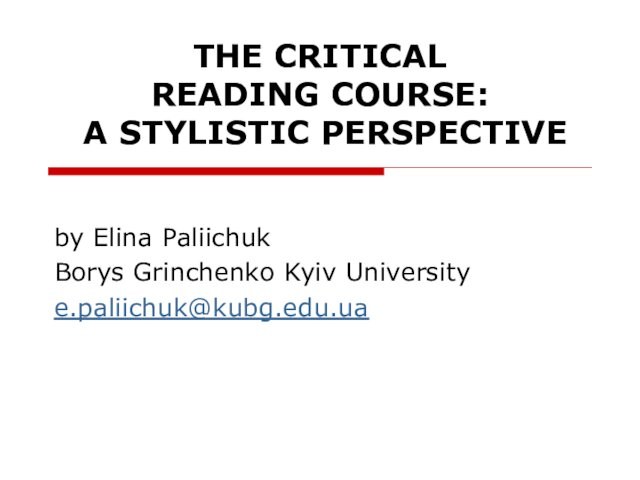
Paliichuk
Borys Grinchenko Kyiv University
e.paliichuk@kubg.edu.ua
Слайд 2
PHONO-GRAPHICAL LEVEL
SOUND INSTRUMENTING, GRAPHON. GRAPHICAL MEANS
30-31/03/2015
Elina Paliichuk
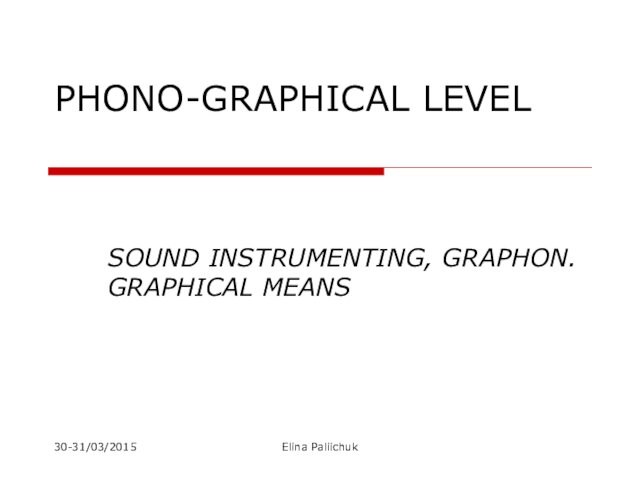
Слайд 3
Phonemic and Graphemic Foregrounding
Dealing with various cases
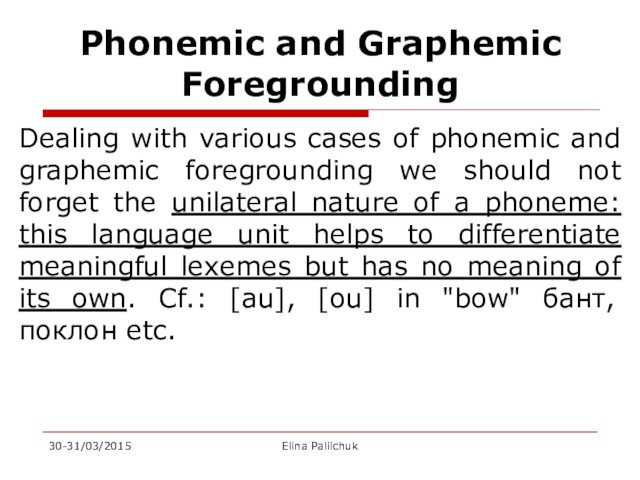
of phonemic and graphemic foregrounding we should not forget
the unilateral nature of a phoneme: this language unit helps
to differentiate meaningful lexemes but has no meaning of its own. Cf.: [au], [ou] in «bow» бант, поклон etc.
30-31/03/2015
Elina Paliichuk
Слайд 4
30-31/03/2015
Elina Paliichuk
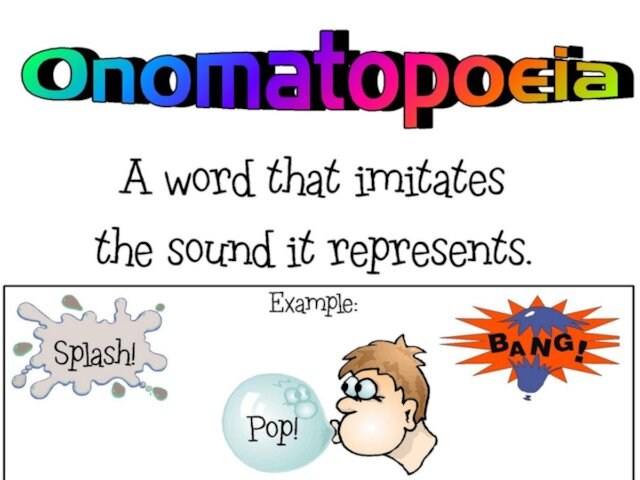
Слайд 5
Onomatopoeia
Still, devoid of denotational or connotational meaning, a
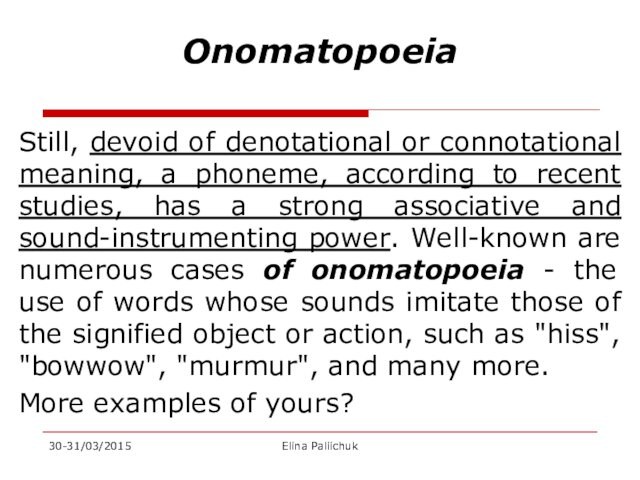
phoneme, according to recent studies, has a strong associative
and sound-instrumenting power. Well-known are numerous cases of onomatopoeia —
the use of words whose sounds imitate those of the signified object or action, such as «hiss», «bowwow», «murmur», and many more.
More examples of yours?
30-31/03/2015
Elina Paliichuk
Слайд 6
Definition
Onomatopoeia is a deliberate use of words or combinations
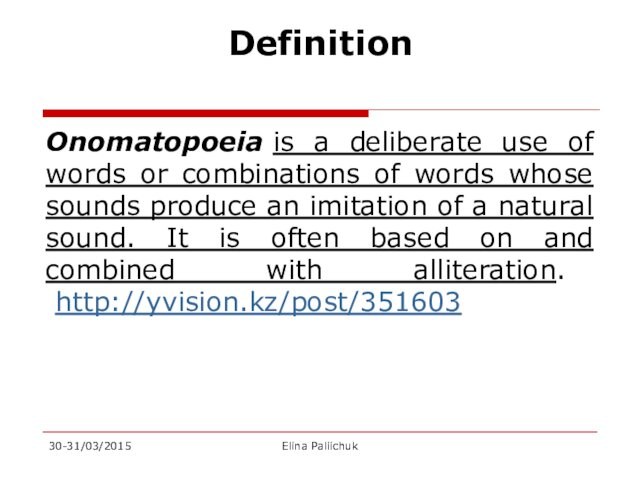
of words whose sounds produce an imitation of a
natural sound. It is often based on and combined with
alliteration.
http://yvision.kz/post/351603
30-31/03/2015
Elina Paliichuk
Слайд 7
Onomatopoeia Types:
Direct, contained in words that imitate natural
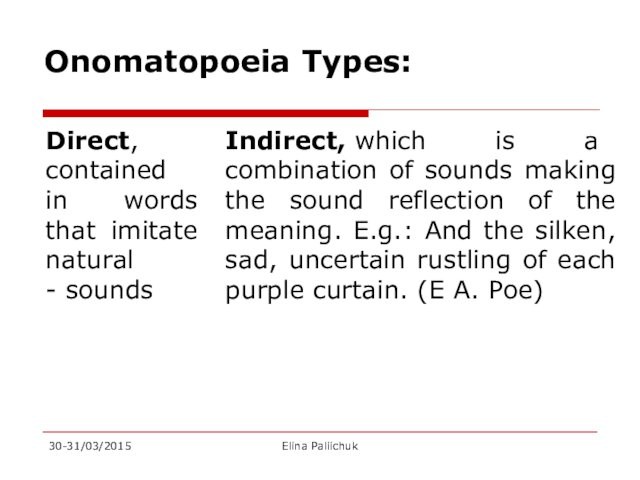
— sounds
Indirect, which is a combination of sounds making the sound
reflection of the meaning. E.g.: And the silken, sad, uncertain
rustling of each purple curtain. (E A. Poe)
30-31/03/2015
Elina Paliichuk
Слайд 8
30-31/03/2015
Elina Paliichuk
http://yvision.kz/post/351603
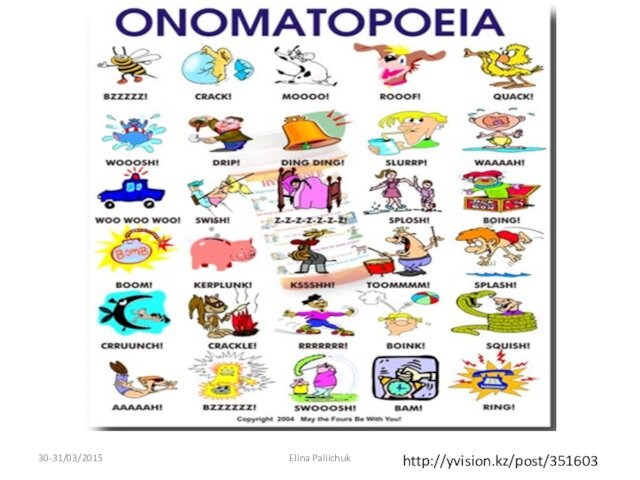
Слайд 9
Poetry abounds in some specific types of sound-instrumenting,
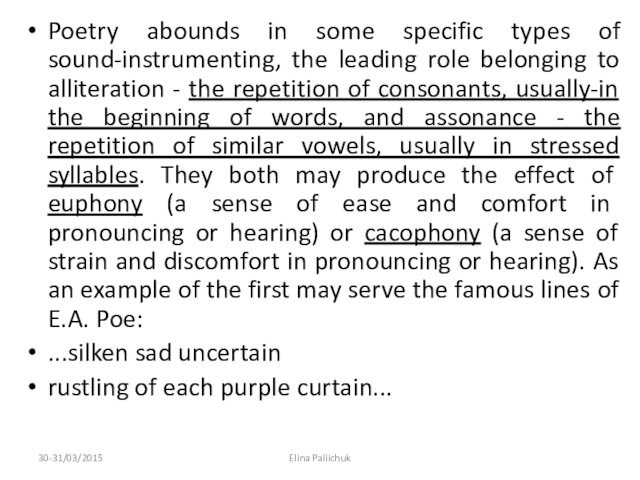
the leading role belonging to alliteration — the repetition
of consonants, usually-in the beginning of words, and assonance —
the repetition of similar vowels, usually in stressed syllables. They both may produce the effect of euphony (a sense of ease and comfort in pronouncing or hearing) or cacophony (a sense of strain and discomfort in pronouncing or hearing). As an example of the first may serve the famous lines of E.A. Poe:
…silken sad uncertain
rustling of each purple curtain…
30-31/03/2015
Elina Paliichuk
Слайд 11
Alliteration
is the repetition of a particular sound in
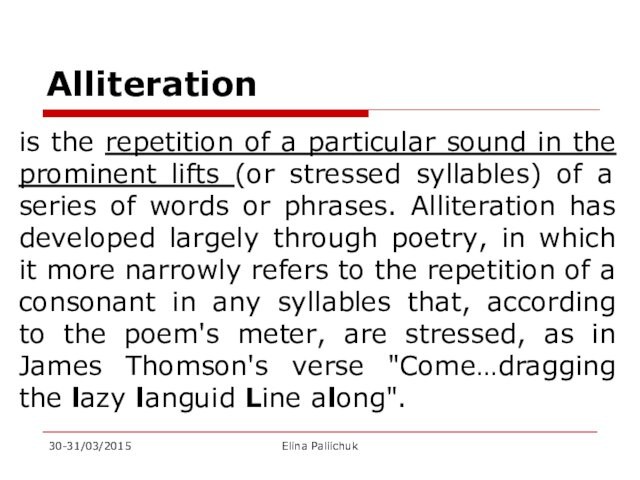
the prominent lifts (or stressed syllables) of a series
of words or phrases. Alliteration has developed largely through poetry,
in which it more narrowly refers to the repetition of a consonant in any syllables that, according to the poem’s meter, are stressed, as in James Thomson’s verse «Come…dragging the lazy languid Line along».
30-31/03/2015
Elina Paliichuk
Слайд 13
Assonance
is the repetition of vowel sounds to create
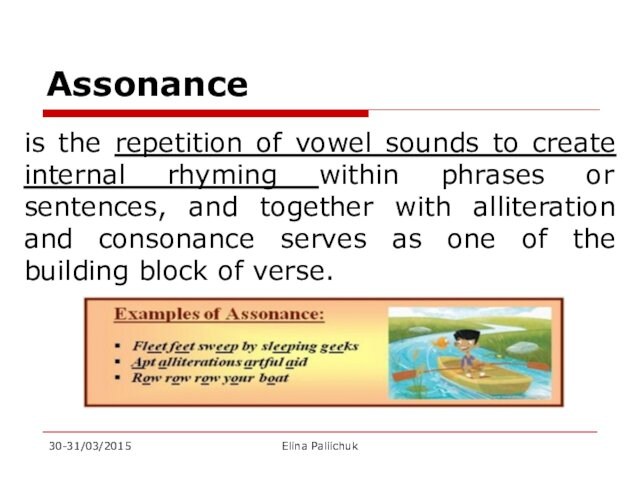
internal rhyming within phrases or sentences, and together with
alliteration and consonance serves as one of the building block
of verse.
30-31/03/2015
Elina Paliichuk
Слайд 15
Rhyme
is a characteristic feature of poetry but in
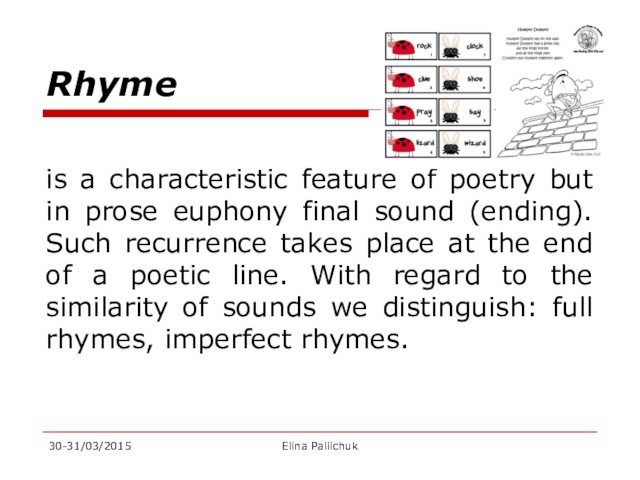
prose euphony final sound (ending). Such recurrence takes place
at the end of a poetic line. With regard to
the similarity of sounds we distinguish: full rhymes, imperfect rhymes.
30-31/03/2015
Elina Paliichuk
Слайд 16
With regard to the structure of rhymes we
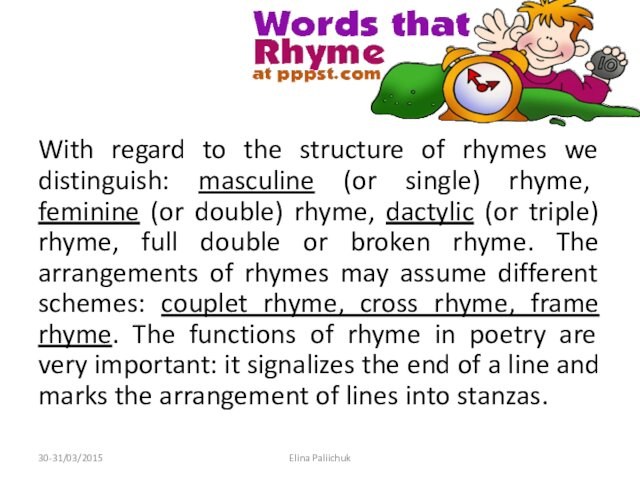
distinguish: masculine (or single) rhyme, feminine (or double) rhyme,
dactylic (or triple) rhyme, full double or broken rhyme. The
arrangements of rhymes may assume different schemes: couplet rhyme, cross rhyme, frame rhyme. The functions of rhyme in poetry are very important: it signalizes the end of a line and marks the arrangement of lines into stanzas.
30-31/03/2015
Elina Paliichuk
Слайд 17
Rhythm
is a regular alteration of similar or equal

units of speech. It is sometimes used by the
author to produce the desired stylistic effect, whereas in poetry
rhythmical arrangement is a constant organic element, a natural outcome of poetic emotion.
Example: The fallibly irrevocable cat met its intrinsic match in the oppositional form of a dog.
30-31/03/2015
Elina Paliichuk
Слайд 18
Graphon
To create additional information in a prose discourse
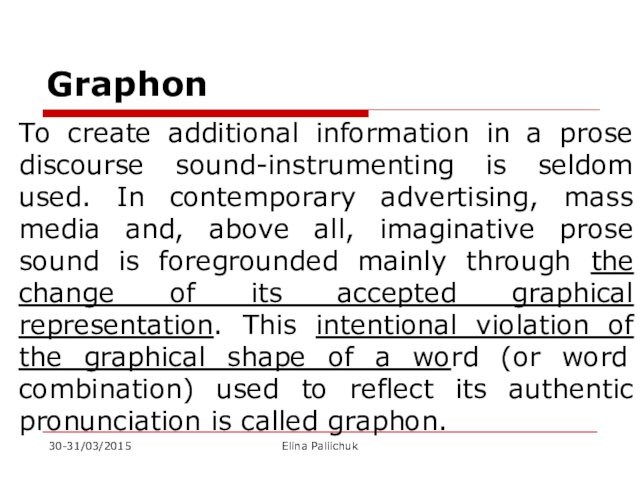
sound-instrumenting is seldom used. In contemporary advertising, mass media
and, above all, imaginative prose sound is foregrounded mainly through
the change of its accepted graphical representation. This intentional violation of the graphical shape of a word (or word combination) used to reflect its authentic pronunciation is called graphon.
30-31/03/2015
Elina Paliichuk
Слайд 19
«The b-b-b-b-bas-tud-he seen me c-c-c-c-com-ing» in R. P.

Warren’s Sugar Boy’s speech or «You don’t mean to
thay that thith ith your firth time» (D.C.) show the
physical defects of the speakers — the stumbling of one and the lisping of the other.
cliches in contemporary prose dialogue: «gimme» (give me), «lemme» (let me), «gonna» (going to), «gotta» (got to), «coupla» (couple of), «mighta» (might have), «willya» (will you), etc.
«Pik-kwik store», or «The Donut (doughnut) Place», or the «Rite Bread Shop», or the «Wok-in Fast Food Restaurant», etc. «Sooper Class Model» cars, «Knee-hi» socks, «Rite Aid» medicines.
30-31/03/2015
Elina Paliichuk
Слайд 20
According to the frequency of usage, variability of
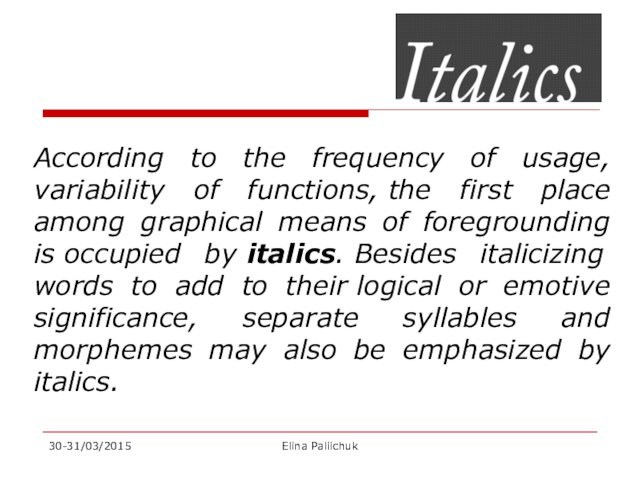
functions, the first place among graphical means of foregrounding is occupied
by italics. Besides italicizing words to add to their logical or emotive significance,
separate syllables and morphemes may also be emphasized by italics.
30-31/03/2015
Elina Paliichuk
Слайд 21
Intensity of speech (often in commands) is transmitted
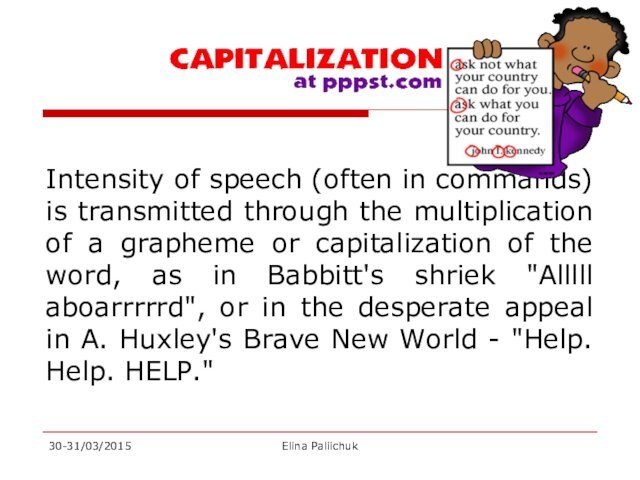
through the multiplication of a grapheme or capitalization of
the word, as in Babbitt’s shriek «Alllll aboarrrrrd», or in
the desperate appeal in A. Huxley’s Brave New World — «Help. Help. HELP.»
30-31/03/2015
Elina Paliichuk
Слайд 22
Hy-phe-nation
of a word suggests the rhymed or clipped
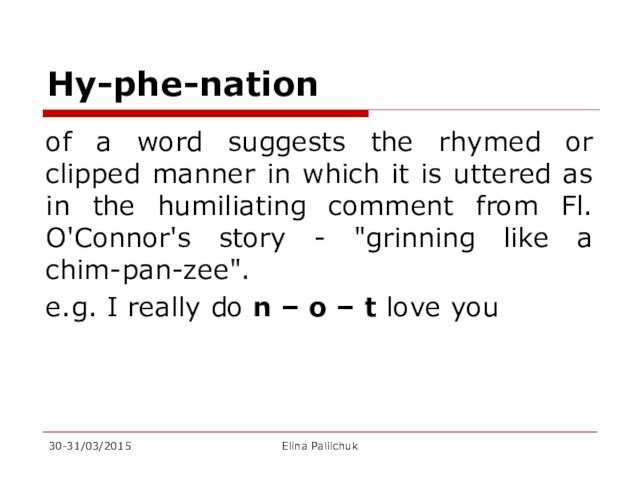
manner in which it is uttered as in the
humiliating comment from Fl. O’Connor’s story — «grinning like a
chim-pan-zee».
e.g. I really do n – o – t love you
30-31/03/2015
Elina Paliichuk
Слайд 23
Shaped (Visual) Text
a text,
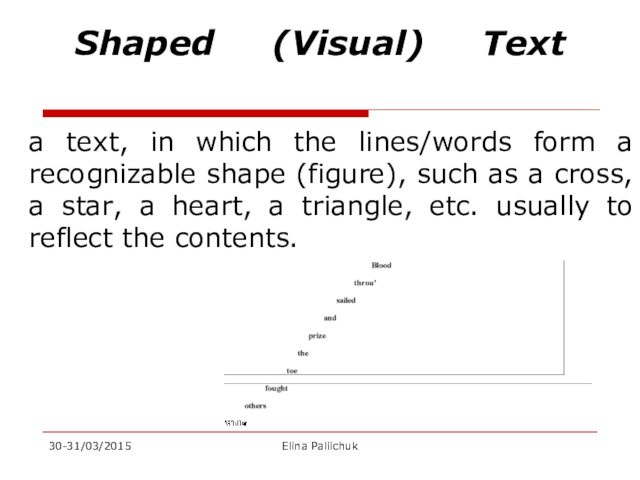
in which the lines/words form a recognizable shape (figure),
such as a cross, a star, a heart, a triangle,
etc. usually to reflect the contents.
30-31/03/2015
Elina Paliichuk
Слайд 24
Discussion
What is sound-instrumenting? Types?
What is graphon? Its
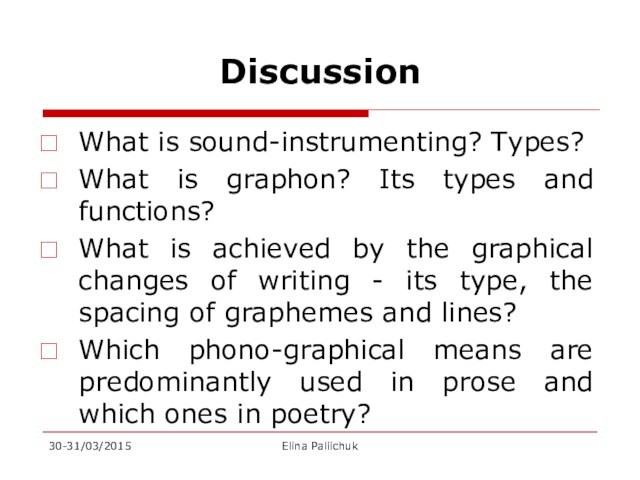
types and functions?
What is achieved by the graphical
changes of writing — its type, the spacing of graphemes
and lines?
Which phono-graphical means are predominantly used in prose and which ones in poetry?
30-31/03/2015
Elina Paliichuk
Слайд 25
Indicate the causes and effects of the following
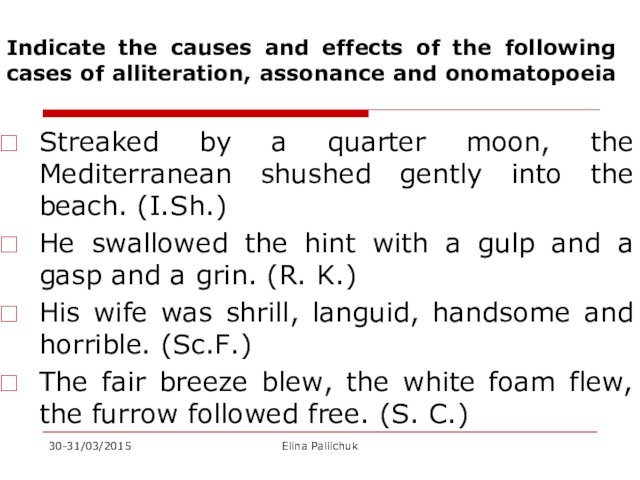
cases of alliteration, assonance and onomatopoeia
Streaked by a quarter
moon, the Mediterranean shushed gently into the beach. (I.Sh.)
He swallowed
the hint with a gulp and a gasp and a grin. (R. K.)
His wife was shrill, languid, handsome and horrible. (Sc.F.)
The fair breeze blew, the white foam flew, the furrow followed free. (S. C.)
30-31/03/2015
Elina Paliichuk
Слайд 26
Indicate the kind of additional information about the
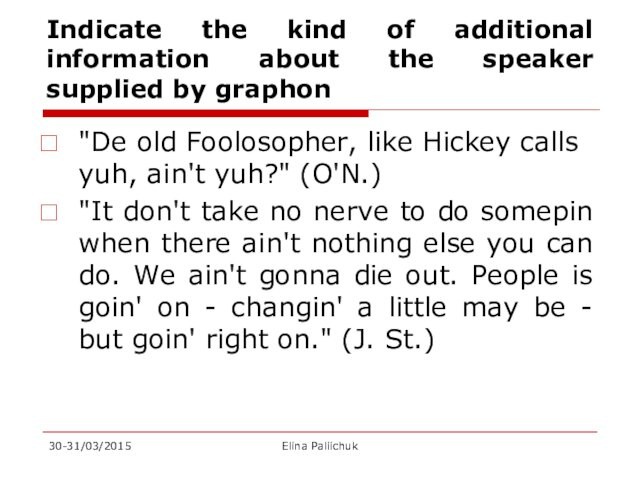
speaker supplied by graphon
«De old Foolosopher, like Hickey calls
yuh, ain’t yuh?» (O’N.)
«It don’t take no nerve to do
somepin when there ain’t nothing else you can do. We ain’t gonna die out. People is goin’ on — changin’ a little may be — but goin’ right on.» (J. St.)
30-31/03/2015
Elina Paliichuk
Слайд 27
Think of the causes originating graphon (young age,
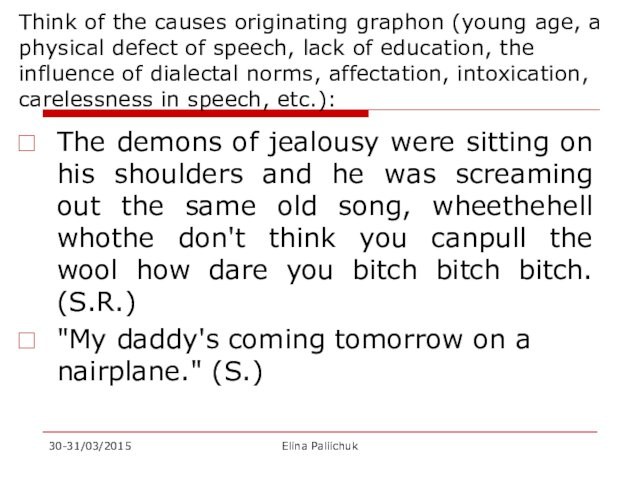
a physical defect of speech, lack of education, the
influence of dialectal norms, affectation, intoxication, carelessness in speech, etc.):
The
demons of jealousy were sitting on his shoulders and he was screaming out the same old song, wheethehell whothe don’t think you canpull the wool how dare you bitch bitch bitch. (S.R.)
«My daddy’s coming tomorrow on a nairplane.» (S.)
30-31/03/2015
Elina Paliichuk
Слайд 28
State the function of graphon in captions, posters,
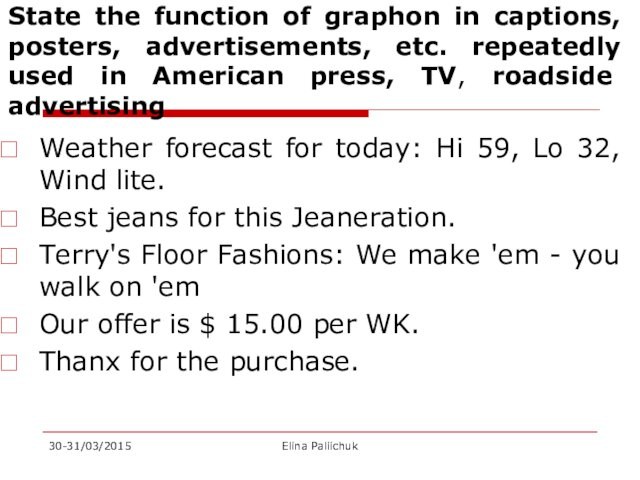
advertisements, etc. repeatedly used in American press, TV, roadside
advertising
Weather forecast for today: Hi 59, Lo 32, Wind lite.
Best
jeans for this Jeaneration.
Terry’s Floor Fashions: We make ’em — you walk on ’em
Our offer is $ 15.00 per WK.
Thanx for the purchase.
30-31/03/2015
Elina Paliichuk
Слайд 29
CASE STUDY 1
You work at a large promotion
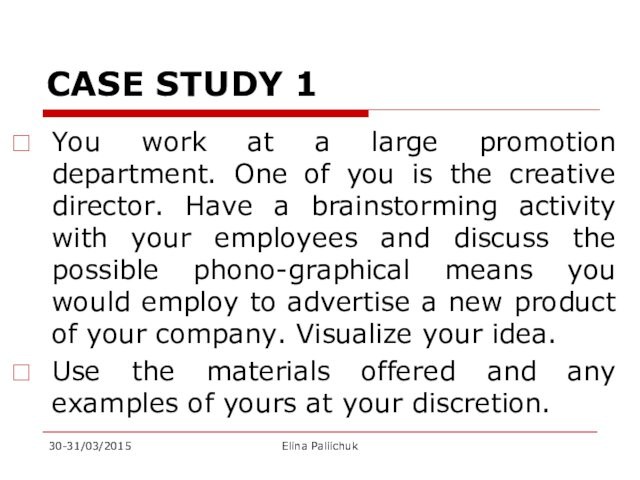
department. One of you is the creative director. Have
a brainstorming activity with your employees and discuss the possible
phono-graphical means you would employ to advertise a new product of your company. Visualize your idea.
Use the materials offered and any examples of yours at your discretion.
30-31/03/2015
Elina Paliichuk
Слайд 30
ASSIGNMENT
Кухаренко В.А. Практикум з стилістики англійської мови: Підручник.

– Вінниця. «Нова книга», 2000 — 160 с.
Word and
its Semantic Structure. Connotational Meanings of a Word. The Role
of the Context in the Actualization of Meaning. Stylistic Differentiation of the Vocabulary. Literary Stratum of Words. Colloquial Words.
30-31/03/2015
Elina Paliichuk
Слайд 31
Conclusions
Summing up the informational options of the graphical
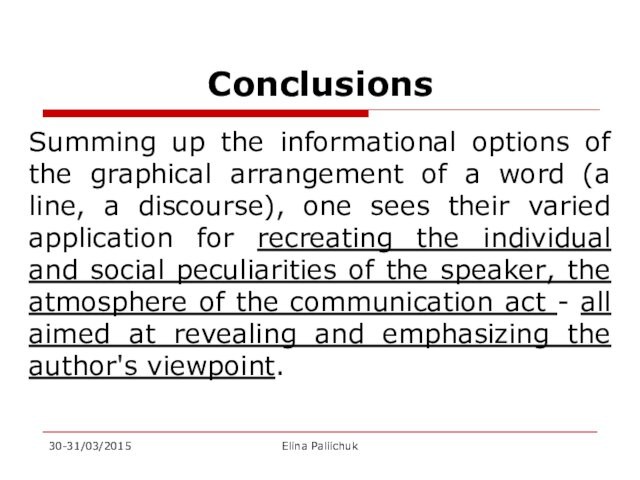
arrangement of a word (a line, a discourse), one
sees their varied application for recreating the individual and social
peculiarities of the speaker, the atmosphere of the communication act — all aimed at revealing and emphasizing the author’s viewpoint.
30-31/03/2015
Elina Paliichuk
